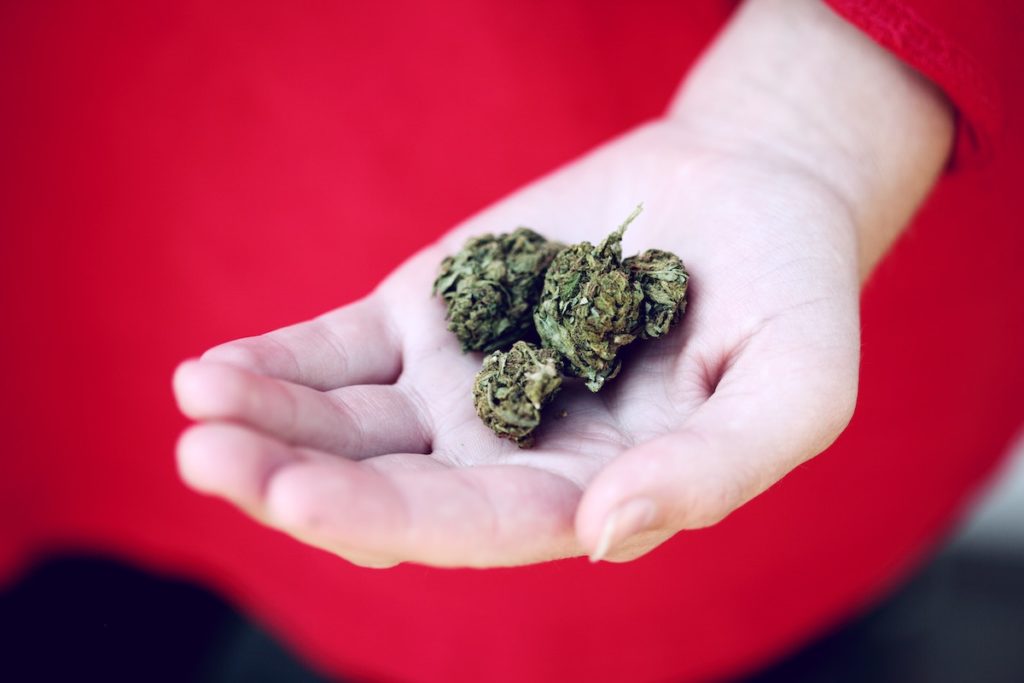
Cannabis is beginning to become legal in more countries than ever. In the last 18 years, 36 countries have sanctioned the medical or recreational use of the drug, in addition to multiple US states. Governments and individuals are seeing cannabis less and less as a gateway to a life of destitution. Despite this, research into cannabis is still slow (mostly because the law still blocks research from happening) and the specific downsides of frequent cannabis use are unclear.
The vast majority of cannabis studies have focused on clinical populations, emphasising the social, psychological, and genetic factors that may contribute to harm from use. Evidence in adults suggests that cannabis is associated with higher risk for developing symptoms of psychosis, but the debate is still ongoing as to what degree this association is causal. Conclusions are that high THC (the psychoactive component in cannabis) alongside genetic, social and psychological vulnerabilities can lead to increased risk of psychotic symptoms, particularly paranoia (Freeman et al, 2015). Again, it’s fairly inconclusive to what degree this is a permanent or state-specific effect.
However, components of cannabis have been also found to be therapeutic, and for some a new lease of life. In 2018 there was wide public outcry at the UK government withdrawing cannabis oil from Billy Caldwell, a 12-year-old who suffered from debilitating and rare epilepsy. This sparked a law change in the UK to allow cannabis products for medicinal purposes. While restricted, this will allow the use of cannabis for treating side effects of severe epilepsy and chemotherapy, but early evidence has also suggested its potential for treatment in arthritis, irritable bowel syndrome, and multiple sclerosis. These treatments often use refined compounds found in cannabis (like CBD or THC) administered in controlled doses.
While current research can help patch up our understanding of cannabis’ effects in adulthood, its recreational use in adolescence is less known, and further still whether effects are long lasting. The beneficial use of cannabis in cases such as Billy’s are clear, but most often cannabis isn’t used in adolescents because of a severe case of epilepsy. A recent survey found that between 5-21% of those under 18 in the US have used cannabis at least once in the past year, but this is smaller than the percentage that use tobacco (7-30%) and alcohol (17-33%). While the risks of alcohol and tobacco are more clearly defined, the evidence for cannabis is murkier. Much like video games and digital technology, it may be that the intuitive negative feelings about cannabis are exaggerated.
So, the pressing question is what are the risks and potential benefits of using cannabis on the developing brain, and more importantly, can it be reversed? Not only will answering this question help give some basic science around neural regulation but it will help inform clinical practice as to the risk of developing poorer health in adulthood.
A recent meta-analysis by J Cobb Scott and colleagues at the University of Pennsylvania was conducted to provide the first substantive quantitative summary looking at cannabis use and abstinence in adolescence and young adulthood, and its impact on cognition (Scott et al, 2018).

A recent change in UK law allows for some use of cannabis products for medicinal purposes.
Methods
Authors conducted a meta-analysis of cross-sectional observational data to assess how frequent, heavy, or problematic cannabis use (and subsequent abstinence) in adolescents and young adults (under the age of 26) effected cognition. MOOSE guidelines were followed for reporting meta-analyses in observational data.
Longitudinal data was disregarded because of the ‘heterogeneity in length of follow-up and methods of reporting cognitive data’.
2,592 initially retrieved studies were whittled down to 69 which were published between 1973 and 2017. These were predominantly from Europe (including the UK), Australia and the United States.
Ten different cognitive domains were used as outcomes, these were: learning, motor, attention, executive function (abstraction/shifting, updating/working memory, and inhibition), delayed memory, speed of information processing, verbal/language processing, and visuospatial functioning.
There was considerable heterogeneity in how these general cognitive domains were tested between studies, e.g. attention could have been measured by one of 21 tests, but most frequent was the WAIS-III.
To account for this wide variety of outcomes, mixed-effects multivariate models in STATA were used to allow for multiple outcomes per study. Authors wanted to examine the variability of effect sizes between studies and how these related to their fixed cognitive factors.
Results
- 8,727 participants were included in total across studies, with 2,152 heavy or frequent cannabis users. Most cannabis users were male (68.1%) and averaged an age of 20.6. On average, cannabis use started at 15.2 years.
- Overall for cognition, and after accounting for some publication bias, an effect size of -0.206 was found indicating reduced cognitive function, but this is not straightforward:
- When analysing specific cognitive domains only verbal/language, visuospatial, and motor functioning were not impaired
- The largest reductions in function were in learning, which had an effect size of -0.33
- There was no significant effect of age, age at first use, or depression on reductions in cognitive function
- However, for heavy cannabis users that were seeking treatment the effect of cognitive change was significantly greater in magnitude than those who didn’t seek treatment.
- Finally, analysing studies reporting abstinence from cannabis (n = 1,661) found that abstinence reduced the magnitude of reduced cognitive function. Abstaining from cannabis for 72 hours was found to impact effect sizes across studies, such that cognitive function didn’t significantly reduce from those who didn’t smoke cannabis frequently or heavily.

This review suggests that associations between cannabis use and cognitive functioning in adolescents and young adults are small and may be of questionable clinical importance for most individuals.
Discussion
Overall, results suggest that frequent and heavy cannabis use can reduce cognitive function on average in young people. However, as the authors note, these results may be inflated estimates and the effects might very well go away after abstaining for 72 hours.
The most significant effect association was between cannabis use and learning rates. The dopaminergic system underlies the reward and learning mechanisms we use to build and develop interpretative models of the world. Evidence in adults has suggested that cannabis can produce dysregulation in dopaminergic pathways (van de Giessen et al, 2017). Whether cannabis has a deleterious effect on learning may lie in understanding how dopamine firing is regulated throughout the transition from adolescence to adulthood.
However, from the nature of the data we can’t draw too many conclusions about the direct impact of cannabis in a young person picked at random. Cross-sectional data can give us a good general overview about how one variable may impact another but isn’t able to tell us the direction of causality. It may be that those with lower cognitive function smoke more cannabis anyway, or that other risk factors lead to cannabis having an acute impact. Indeed, the authors downplay the role of cannabis use on cognition in adolescence, pointing to the potential for inflated estimates and study bias. When looking outside of this immediate study at cohort data we might be able to frame these claims with more clarity.
When looking at longitudinal data we get even more mixed evidence. A multicentre effort to characterise the IQ and neuropsychological ability of a large sample (over 1,000 people) found that cannabis dependence significantly reduced IQ and cognition (Meier et al, 2012). This was after accounting for tobacco use, recent cannabis use, other drug and alcohol use, and a diagnosis of schizophrenia. Crucially, drops in IQ at age 38 were found in those who used cannabis weekly before the age of 18 but not in those who didn’t. A smaller study found something similar: using cannabis at an earlier age led to poor neurocognitive ability at 2 years. However, a recent twin study found that while those who smoked cannabis more had a lower IQ, they were consistently lower than their non-cannabis smoking peers even before using cannabis (Meier et al, 2017). There wasn’t any evidence to suggest cannabis specifically diminished their IQ or cognitive ability between the ages of 5 and 18. Cleary the use of cannabis is associated with lower cognition and IQ over time, but whether this is due to cannabis or not is not fully clear.

The use of cannabis is associated with lower cognition and IQ over time, but it remains unclear whether this is actually caused by cannabis use or other factors.
An important factor in reducing the potential impact of cannabis use on later decline in cognitive function will be in education toward the risks of use and individual vulnerability. There may be protective factors in some that prevent cannabis use from impacting cognition; those who sought help in this study had significantly larger reductions in cognitive function than those who didn’t. In addition, the present data do not differentiate between cannabis type, composition, or administration method, and so we can’t tell how gradations of THC concentration or smoked vs eaten cannabis might vary cognition. The form and manner in which cannabis is used is important to its effect (Newmeyer et al, 2016), and this information is nothing new. Eating cannabis products for example has a differential effect than smoking or inhaling it, and frequent users have less dramatic effects.
We really need research that investigates whether it’s possible to reverse or even improve cognition after abstaining from cannabis use or dependence in adolescence. Data from this meta-analysis found reductions in effect size magnitudes when participants abstained from cannabis. Finding this consistently would mean that cannabis is much more of an acute cognitive modifier rather than a chronic one. Understanding how cannabis may impact cognitive function in the long term will take a robust longitudinal meta-analysis, but we’re a little way off that yet.
I’m left with more questions than answers after reading this study. But, considering the clear risk that alcohol and tobacco can have on health, it’s surprising that cannabis is feared to such an extent. A lot of this can be solved with honest education around the risks of cannabis use. As always, let’s hope the evidence leads the way.

According to this research, abstinence from cannabis use of longer than 72 hours diminishes the cognitive deficits associated with use.
Links
Primary paper
Scott JC, Slomiak ST, Jones JD, Rosen AFG, Moore TM, Gur RC. (2018) Association of Cannabis With Cognitive Functioning in Adolescents and Young Adults: A Systematic Review and Meta-analysis. JAMA Psychiatry. 2018; 75(6): 585–595. doi:10.1001/jamapsychiatry.2018.0335
Other references
Freeman D, Dunn R, Murray RM. et al , (2015) How Cannabis Causes Paranoia: Using the Intravenous Administration of ∆ 9 -Tetrahydrocannabinol (THC) to Identify Key Cognitive Mechanisms Leading to Paranoia, Schizophrenia Bulletin, Volume 41, Issue 2, 1 March 2015, Pages 391–399. https://doi.org/10.1093/schbul/sbu098
van de Giessen E, Weinstein JJ, Cassidy CM. et al (2017) Deficits in striatal dopamine release in cannabis dependence. Molecular Psychiatry Published: 22 March 2016 Volume 22, Pages 68–75.
Meier MH, Caspi A, Ambler A. (2012) Persistent cannabis users show neuropsychological decline from childhood to midlife. PNAS October 2, 2012 109 (40) E2657-E2664. https://doi.org/10.1073/pnas.1206820109
Becker MP, Collins PF, Schultz A. et al (2017). Longitudinal changes in cognition in young adult cannabis users. Journal of Clinical and Experimental Neuropsychology. Pages 529-543 | Received 16 Mar 2017, Accepted 11 Sep 2017, Published online: 23 Oct 2017
Meier MH, Caspi A, Danese A, Fisher HL, Houts R, Arseneault L, Moffitt TE. (2017) Associations between adolescent cannabis use and neuropsychological decline: a longitudinal co‐twin control study. Addiction First published: 22 July 2017 https://doi.org/10.1111/add.13946
Newmeyer MN, Swortwood MJ, Barnes AJ. et al (2016) Free and Glucuronide Whole Blood Cannabinoids’ Pharmacokinetics after Controlled Smoked, Vaporized, and Oral Cannabis Administration in Frequent and Occasional Cannabis Users: Identification of Recent Cannabis Intake. Clinical Chemistry DOI: 10.1373/clinchem.2016.263475 Published October 2016
Photo credits
- Cannabis Reports CC BY 2.0
- Photo by Sharon McCutcheon on Unsplash
- Photo by Greta Schölderle Møller on Unsplash
- Photo by K Ch on Unsplash
- Photo by Steven Pahel on Unsplash

I think this article needs a correction to the first line of the discussion, which currently states: “Overall, results suggest that frequent and heavy cannabis use can reduce cognitive function by as much as a third on average in young people.”
Presumably, this refers to the effect size of -0.33 for learning. However this does not mean that cognitive functioning was reduced by as much as a third on average. For instance, if we measured cognitive functioning on a 0-100 scale, assume a standard deviation and sample size of 30 points and 100, respectively, for both groups, then an average score of 80 for cannabis users and 90 for non-users, then this 10-point difference translates to an effect size of -0.33. However if we reduce the SDs to 15, then scores of 85 and 90 also translate to an effect size of -0.33, illustrating the important role of sample variance in estimating standardised effects. Few would feel comfortable describing a 5 or 10 point difference on a 0-100 scale as a reduction in cognitive functioning, on average, of a third. Rather, cognitive functioning is reduced by a third of a standard deviation, which Cohen suggests corresponds to a small-moderate difference.
Using our 0-100 scale, a score of 90 in the non-cannabis group, and an SD of 30, then a reduction in cognitive functioning by a third in the cannabis group would mean they should present with a mean score of 60. This corresponds to a standardised effect size of -1, which would mean the cannabis group were a whole standard deviation lower than the non-cannabis group. If we halve the SDs, then they would be 2 standard deviations lower.
To say that -0.33 of a standard deviation difference means cognitive functioning is reduced by a third, on average, grossly overestimates the difference, and therefore the article really should be corrected.
Hi mike, thanks for this. It’s being corrected. Hope you enjoyed the rest of the blog.
[…] Cannabis use in the developing brain: evidence from a recent cross-sectional meta-analysis […]